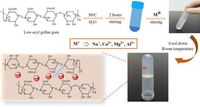A recent study reveals a promising new method for safely extracting fragile artifacts from waterlogged archaeological sites using low-acyl gellan gum.
Traditionally, the extraction of such relics faced numerous uncertainties and dangers, with methods often failing in moist environments. However, this innovative technique introduces gellan gum as a temporary solidification material, which has shown potential for better preserving both the artifacts and their historical context.
Waterlogged archaeological sites present unique challenges for archaeologists, as artifacts buried under such conditions are often delicate and prone to damage. Existing extraction methods are typically designed for use in stable, dry environments, but many valuable relics, such as lacquered wood and textiles, have remained undiscovered due to the difficulties associated with retrieving them intact.
Published in the journal Scientific Reports on March 24, 2025, the study reveals that gellan gum, when used in conjunction with ionic cross-linking, can effectively increase both the strength and safety of the extraction process. By adjusting the types and concentrations of cations like sodium, magnesium, calcium, and aluminum, researchers identified a balance that maximizes gel strength while preventing undesirable clumping.
Specifically, the study highlights that a formulation using 3.0 wt% of calcium chloride can enhance the gel's compressive strength to an impressive 0.11 MPa, making it suitable for handling fragile artifacts.
Dr. X.Q. Chen and his team conducted extensive testing, demonstrating that gellan gum can maintain its stability even at elevated temperatures (up to 75°C), ensuring that the gel retains its integrity during extraction operations.
The mechanics of this new process are quite straightforward: when applied, the gellan gum quickly solidifies around the artifact, forming a transparent, rigid support that upholds the waterlogged relics. This allows archaeologists to extract items safely without needing to remove them from their original environment, thus preserving their integrity and historical significance.
Previous methods, like using cyclododecane and menthol, required specific temperature conditions and had limitations in effective gelling on wet surfaces. However, the low-acyl gellan gum showcases improved hydrophilicity, allowing better application on waterlogged materials. With a contact angle of 38.6°, it outperforms both cyclododecane (101.5°) and menthol (56.8°), giving it significant advantages in application.
This research could transform practices in the field of archaeology by providing a more adaptable and safer method for the conservation of artifacts at sites plagued by moisture damage. Various tests conducted on bamboo slips and ceramic fragments have confirmed the versatility of gellan gum in maintaining structural integrity during the transition from wet to dry conditions.
In doing so, this research not only presents a vital tool for archaeologists but also emphasizes the importance of employing minimal-intervention techniques. By preserving the original state of the artifacts, researchers can prevent alterations that might otherwise compromise their historical significance.
The team emphasizes that while their findings are promising, further research is needed to explore the application of low-acyl gellan gum in different field conditions and for various types of cultural relics. As they cautiously approach larger-scale applications, the findings open the door for future innovations in archaeological practices focused on conservation and preservation.
In conclusion, as the field of archaeology evolves, so too do the tools and methodologies that ensure our cultural history is preserved for future generations. Gellan gum's potential provides a glimpse into more effective methods for excavation and conservation, proving itself to be a game-changer in safeguarding our fragile archaeological heritage.




